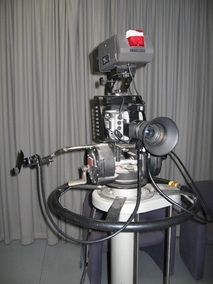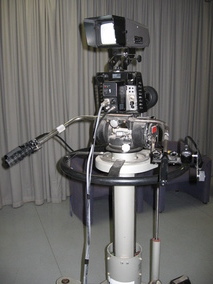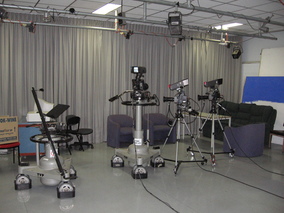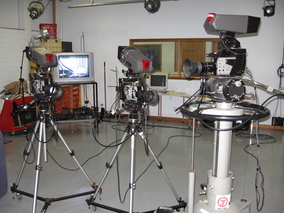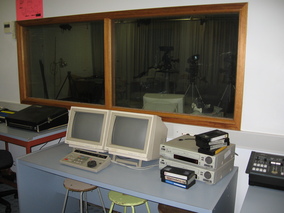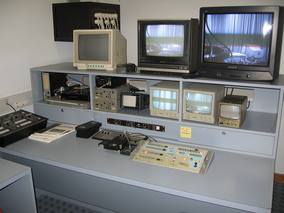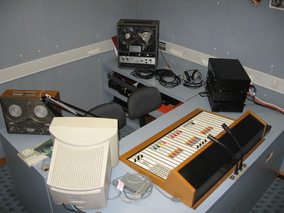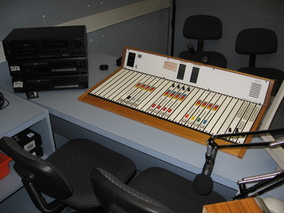Since the 1970s, Para Vista High School, then renamed to Valley View Secondary School, has had a television studio, as part of their media studies faculty. Over the years, it's moved about, from originally being in the resource centre (next to the library, where the BBC computers were in the 1980s, now a book room), moved to the former locker area (next to the loos by the junior block building), then into the junior block (in what was the downstairs science lab), in the 1990s. The first move, into the locker area, being prompted because of the noise disrupting the library. The second move by someone obsessed with re-arranging the layout of the school, with the exception of the area that they worked in, and who probably didn't know that they'd be re-creating the noise problems (the studio disrupting other classes, and vice versa). With that last move being a bit of a downgrade, for moving the studio into a room that was really too small for camera work (you can't place the cameras far back enough to get a good wide-shot, it's around half the size of the previous studio).
There's been a few different teachers looking after it; Bruce Ledo (????–1980s, who'd built some of the equipment), Grant Brindal (1980s–1990s, who was responsible for the changeover to colour, adding chromakey, computer graphics, and VHS editing capabilities), Bob Karutz (1990s–2000s, who looked after the move into the junior block, an upgrade from single-tube cameras to single-CCD cameras, and an upgrade from cobbled together radio studio to a proper radio mixer console), and Grant Brindal came back until 2011 (having to deal with a multitude of digital equipment that doesn't quite talk to each other, inadequate funding, and the eventual decimation of the studio). And I'd looked after it from about 1988 to the 2000s, doing repairs, customisations, building equipment, and occasionally helping students learn how to use a studio.
It's also changed from using industrial black and white video equipment (when the studio was in the library and its move next to the junior block), to industrial colour video equipment (in 1984, upgrading in-place in the studio next to the junior block), moving into the old downstairs science lab inside the junior block, in the 1990s), and now to tinker-toy digital video equipment (still downstairs in the old junior block science lab room, in 2011). In the past, we'd struggled to get funds, and built some equipment, to make it work like a real studio. There were cameras with a proper manual lens, lens controls on the pan/tilt head arms (with the changeover to colour cameras), large 5-inch viewfinders, and CCUs in the control room. Intercoms between the cameras and control room. Individual preview monitors in the control room, which eventually were given tally lights. Small versions of separate audio and vision mixers. An industrial VHS edit suite, later supplemented with a simple S-VHS edit suite, then computerised editing. It'd gone from school-made wooden tripod dollies, to getting some pneumatic pedestals (courtesy of SAS-7), and now back to wimpy little tripods on wheels. And it'd gone from using outdoor pool lighting, to getting a small lighting mixer and few theatre luminaires.
And what do they have now? A new ill-experienced teacher given something like $60,000 to spend as they saw fit, and mis-spend it they did (and they had a record of poorly setting up recording studios in different schools that get rapidly abandoned). Replacing everything (that was still working fine, and easy to understand how to use) with a couple of camcorders on crappy tripods, connected to a digital mixer that's manages to be technical overkill but functionally inferior to the first analogue colour video mixer installed in the mid-1980s. Oh, and they didn't know how to use the equipment they put in, either (amusingly, a rival company supplier, Sony, was asked to provide training, but they refused). The cameras have no proper lens, no lens controls, and tiny midget viewfinders. There's no return video from the mixer to the cameras (so you can't, properly, set up any multi-camera effects shots), no tally lights, and no intercom. A studio freshly painted in peculiar colours, that are going to be a production problem from light reflections, confused auto white balances, and the eyes being tricked. The removal of the monitor from the studio floor, and the preview monitors from the control room. It looks like they're taking sound from the microphones in the camcorders, since I could see no connection between the audio equipment and the video recording equipment. If anything, it looks like they're demoting the television studio down to a poor sound studio (which makes little sense, since the music department is the most logical place to set up a sound recording studio), with some slight capability to record video, as well. So, gone is the chance to do proper studio productions.
You might ask, “Why does a school need a tv studio?” There are numerous reasons why it might be a good idea: Media studies is a subject that looks at all sorts of areas of the media (journalism, radio, film, television, print, internet), and part of the process of studying something is to do it yourself (much the same as students studying science, technical studies, art, cooking, et cetera). As well as it's use for study, the film and television production is an industry, and it's useful for students to experience aspects of different industries to help them figure out what they want to do when they leave school. And, until the fairly recent availability of home video equipment, and computer editing, the chance to make a production was fairly limited to most people, so having production equipment in a school might well be the only chance to make a production for many students. And might be the only chance, in their lifetime, to experience working in a studio environment, particuarly as all the commercial stations in Adelaide have got rid of their studios (their newsrooms being a poor substitute, and mostly automated). Students have used the studio to film presentations for their classes, such as making a report on a subject that includes themselves speaking, and other pictures of what their report is about. They've been able to use the equipment for their own productions (and there aren't too many school subjects where students are keen to do more work on they they're told to).
So there is a use for it, and when a studio is set up to last for a decade or so, the equipment cost isn't too exorbitant, and comparable to other faculties (e.g. machinery in tech studies). And it was one of the few subjects to teach co-operative teamwork, as opposed to competitive teamwork. Something that's sadly lacking in today's world, and the worth of that would be appreciated by anybody who's had to put up with lazy or backstabbing colleagues in their job.
But that ship has sailed, now that money has been thrown at (allegedly) an upgrade, but the reality being quite different, with decisions made by people without the experience and knowledge to do it properly, being sold a solution by musical equipment retailers without a video production background, and against advice from those with the experience and knowledge. And the media studies course falling away from studying the media, and learning how to make a production, to aimlessly playing with audio–video toys.
As a former media studies student at this school, and having worked at the school maintaining and upgrading the studio for many years, I'm extremely disappointed by the lack of foresight by the school for what they've done in destroying what was a unique facility in South Australian public schools. One that was better equipped than most schools in the state, with only a few having anything nearly comparable, and even better than the community television station.
When I left the school, I knew how to work in a television studio, and worked with some people from the ABC, knowing exactly what to do. The same cannot be said for the media studies department, now. The current equipment, is unsuitable. And the lack of knowledge in the teaching staff, shocking.
VVSS TV & radio studios, 1990s–2011
Full sized pictures can be seen by clicking on these small preview images. These are the facilities that I put together for them:
